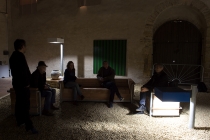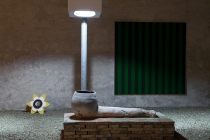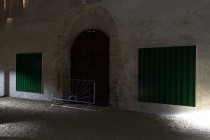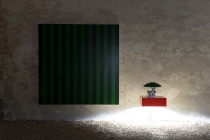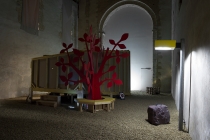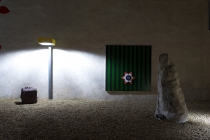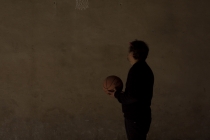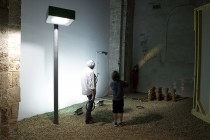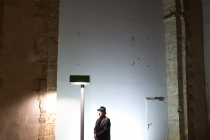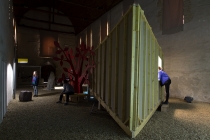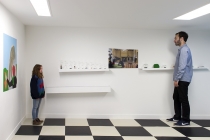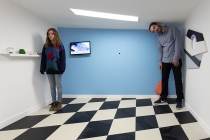Chapelle du Genêteil, Château-Gontier, France.
30th May to 30th August 2015.
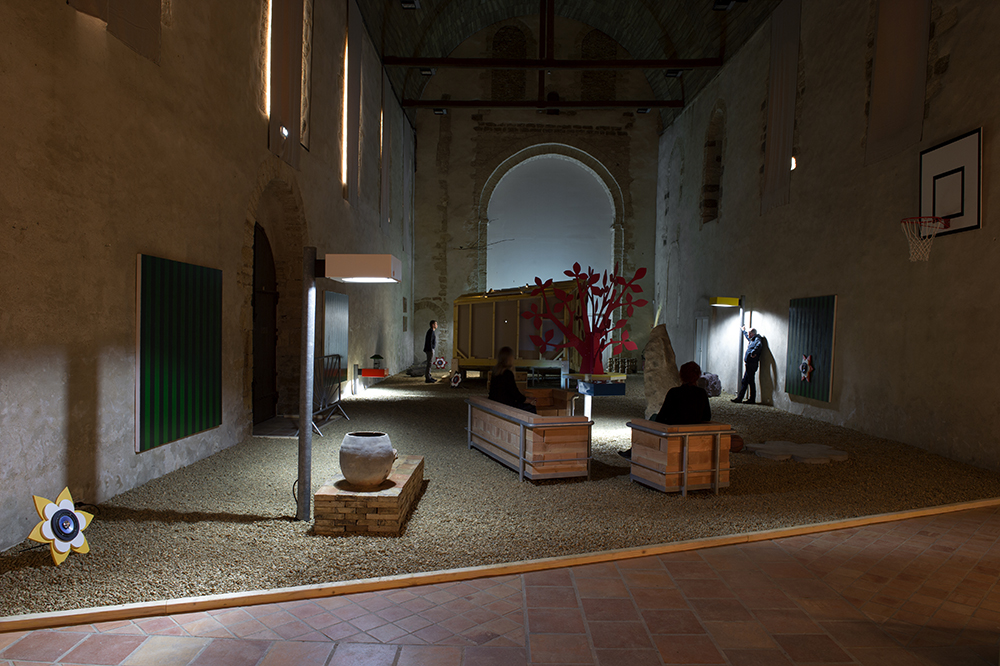
DMC : From Mademoiselle Hulaut, you went to Detective Hulaut. Now you are doing Sam Moore. Where does this fascination for characters and alter-egos come from? Can we associate it with the work of Cindy Sherman? Or even Marcel Duchamp?
AH : I am fascinated by Cindy Sherman and the characters that she incarnates, but I’m also fascinated by artists whose entire work is an enigma, like Raymond Hains or Marcel Duchamp. Effectively I am interested in the question of identity, its representation, its transposition and its eventual mutation from one personage into another. As individuals we are richer than we think, and by taking on different personalities, one can access other ways of seeing and reacting to this world. I can’t stop myself trying it out. My approach is to question the gap between real life and fiction, or between art and its representation, or simply between art and life. The notion of the personage, like the detective, allows me to keep a certain distance. One foot on either side of this delicate fissure, to go back and forth between light and dark, between haziness and clear vision. One has to remember to change one’s glasses all the time.
In my case, the alter-ego is also a pretext to meeting others: people, materials or places. It’s also a way to project oneself into another narrative that is never foretold. I put things in place, activate situations, and as a result a character comes into being, a certain mechanism starts to kick in.
DMC : So how was Sam Moore born?
AH : The story begins with a sculpture, an illusionistic space that I made following the principals set out by the optician, Adelbert Ames. He discovered that the human eye is capable of rationalizing and rectifying a trapezoidal space that is completely deformed. People situated inside these kind of spaces can appear to be very small or very big. These kings of spaces are known as «Ames Rooms», after their inventor.
I really wanted to experiment with this kind of space. It makes me think of the camera, the photographic box, but also of paintings from the XVIIe century. These are enigmas: frames within frames, never-ending loops. And so I created my first Ames Room at Wharf, Hérouville-Saint-Clair, 2013. I wanted to give the work a title. I searched for an anagram of Ames Room and I came up with Sam Moore.
DMC : Ames Rooms only function when you fill them with deformed furniture, so you need to think about what you’re going to put inside. Often we find paintings, windows, doors, a clock.
AH : You can often find these spaces in science museums. They are quite simple, two windows on the wall facing the peep-hole, because that is where the deformation is the most radical. Ideally you need two people inside and one person outside. This brings into play the idea of the «voyeur». The decorative objects are generally used in pairs, identical twin objects, that also sows doubt. I like the idea that the idea of the double appears only by transformation in the eye of the voyeur. The copy, which isn’t really a copy by the way, brings into play the idea of the «other».
DMC : This question of the double links to the idea of the alter-ego. All your characters seem to link up. One character transforms into another. The Detective Hulaut retained certain qualities from Mademoiselle Hulaut. Sam Moore seems to share certain characteristics with the Detective Loupeur, maybe less comic, maybe more american.
AH : With Sam Moore, you’re never sure. There is more freedom. The sculpture carries the name of a character because I wanted to model the sculpture into an individual … an individual within a sort of possible reality of course … but because that comes from a sculpture that is already deformed, a sculpture that already operates within the realm of optical illusion, the reality of Sam could only be a half truth.
DMC : Sam Moore’s studio was the first thing we decided to build in the Chapelle du Genêteil. In your last exhibition, the studio was painted white and the space seemed well aired. This time you want it to be busier, more loaded, more lived in.
AH : Hérouville-Saint-Clair was the beginning. The character of Sam Moore was just beginning to form. A map painted onto the wall brought in the idea of a geography turned upside down. The relation between daily routine and the absurd was evoked in a video. The chequered floor, essential for activating the perspective is always present. The version that I propose here is more linked to a studio or an office. Inside you can look at objects that I have found, interspersed with things that I have made, reality and fiction. The notion of the double is still there. For example there are pebbles shaped like hearts that I found on the beach, and then there are others that I made in my studio. There is a real man’s shaving brush that I associate with something more feminine, like a brush for applying blusher. These objects are often displayed under an inverted wine glass.
The personage of Sam Moore has passed through the field of sculpture quite a few times, but s/he has also been developed through writing, which is also a fundamental part of my practice. I write by articulating objects with events. There are observations, but there are also imaginations. It’s a diary which I call, «the thoughts of Sam Moore». Some times you will find a complicity with the poet, Pierre Giquel. Recently an artist friend, Odile Landry, asked me to use this diary as the starting point for a film.
The other key element in the Studio Sam Moore is a photograph that I made with friends from our neighbourhood. This type of staged photograph is recurrent in my practice. This time I wanted to evoke an interior scene, similar to those in the paintings of Vermeer, which in turn evoke photography.
To construct the Studio Sam Moore in the middle of the Chapelle du Genêteil, forced us to think about the exterior. In this context, the studio is much more of a micro-architecture and by inference, the rest of the chapel becomes a potential garden. If the Studio Sam Moore evokes a «private» space, by opposition, the garden becomes «public».
DMC : Not only « public », but also a version « by night ». When you spoke to me about the Studio Sam Moore, you imagined the light that would come out from the window. Immediately I thought about the paintings of Edward Hopper. But to make that work, we would need to plunge the rest of the chapel into darkness or at least half-light. Many artists would find that too much, but I was intrigued. I had already worked in a real park during my last exhibition. In general, parks are designed for the day, even though it seems obvious to say, the also exist during the night. In the daytime, parks are more or less places for everyone, where parents play with their children, people go jogging, walk their dogs etc. When night falls, they transform into much more mysterious places, illicit meetings take place, adventures under the influence of love, desire, alcohol or other drugs. Between day and night there is a temporal border, it’s called twilight. I was excited by the idea of searching for this lumino-temporal junction, create a space and a light where shadows can hide all sorts of activities, more or less obscure.
My first response was to work on a collection of urban furniture for our new park. I decided to take up a certain modern classic chair that had been design for indoor use and transform it for outdoor conditions. My interest for the modernist movement isn’t just formal. Recently I discovered Le Corbusier’s project for a «club» at the heart of a cooperative village, Piacé-le-Radieux. To perceive architecture and design as a catalyst for social interaction was radical. And so I started to think about our exhibition, our park, as a meeting place.
In the case of the chairs, one can talk of « inside-out » ; in the case of the lampposts, it’s clearly « outside-in ». As with many towns at the moment, Château-Gontier is replacing all its public lighting. I managed to salvage a few old ones. Today, most of our neighbours consider these old square boxes to be ugly, but to me, they remind me of the «specific objects» by Donald Judd.
Our working method was like a tennis match. One is always constrained to return the ball that the other has just served. It becomes a dynamic conversation. Each one listens to the other, formulates a response, and it continues.
AH : The ricochets continue in the exhibition space with this endless coming and going, between inside and outside, which results in a permanent doubt as to the nature of things. One is never sure where one finds oneself. Often one talks of a domestic garden as if it is another room joined on to the house. Today, in municipal parks, you can find outdoor furniture installed just like home, chairs facing each other to invite the conversation.
DMC : It’s a question of familiarity and strangeness. It’s not me who invented the elements that I position in our exhibition. However they are rarely exact copies. For example the paintings that I have installed in the chapel, to limit the space as a hedge might limit a park, evoke the work of Daniel Buren. Other elements evoke the familiar universe of children’s television. «The Magic Roundabout» is a hybrid world made in 2 & 3 dimensions, but the final product was always delivered to us flat on our screens. I wanted to make a 3D version, penetrable. The «Barrière Vauban» is a form and a sign of authority, recognisable to all of us; however this time it has been modified by replacing the bars with a sunset, popular maybe even kitsch motif. The lampposts have changed height. For the Le Corbusier LC2 chairs, the material has changed. Everything I propose is already known, nut here it takes on this strange light. I’m trying to create a disturbance in our memories.
AH : This «disturbance» can also be found in the large artificial rocks that I recently produced as part of Sam Moore’s universe. I think of them as sculptures, but they are also optical illusions, copies, decoys. That’s where the idea comes from to accompany them with a pair of glasses, also false, but which underline the viewpoint, the act of seeing. In the making of the rocks, photography plays a crucial role. To render a sense of scale to these images, I include a pair of glasses. Finally it became essential to keep this idea of an object companion. The glasses are a sort of parasite that entered into the work, but eventually became symbiotic. I treated the glasses in the same way as I treated the stones. The juxtaposition of the two objects together is close to the surrealist principals. One often sees big rocks in public space. In general they are used to stop motor vehicles from entering some common land. Seen like that, these giant stones might represent to a contemporary nomad that which a «Barrière Vauban» represents to an ordinary pedestrian.
DMC : There are also the things that we developed together, like all the gravel on the floor. This wasn’t just a visual element, it’s also an audible part of the show, a sound work if you like. We wanted to get rid of the clic-clac of people heels on the tiles and replace it with the crunch-crunch that is associated with rural footpaths. «Outside-in» again. Does the gravel have the status of a work of art? I don’t know if I’d go that far, but in any case, it’s an artistic gesture. There are other things in the exhibition that share the same ambiguity: the guitar that just as if it has been left in the salon LC2 or the basket-ball hoop that’s hung amid the paintings.
AH : There you are. That’s just about the tour of the exhibition at the Chapelle du Genêteil. There will certainly be confusions, ambiguities, doubts. We can’t say that we didn’t go looking for them. «Doubt» has never been something negative for either of us. On the contrary, it’s more like a motor that propels us through our artistic adventures.
Anabelle Hulaut & David Michael Clarke
Translation : David Michael Clarke
Exhibition views : Marc Domage
Essay : Eva Prouteau
Video guide (french dialogue) : Anabelle Hulaut & David Michael Clarke
Links:
Le Carré, Scène nationale – Centre d’art contemporain

